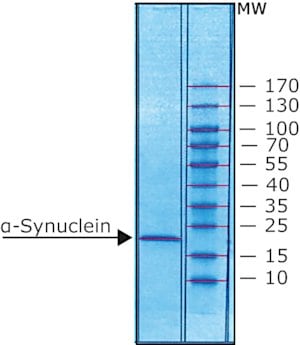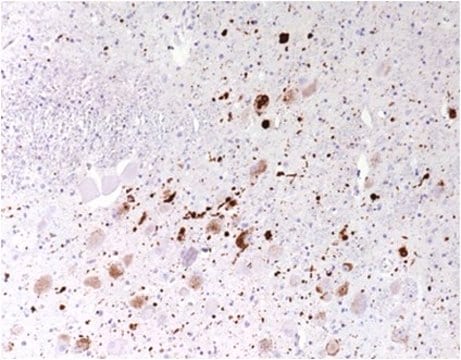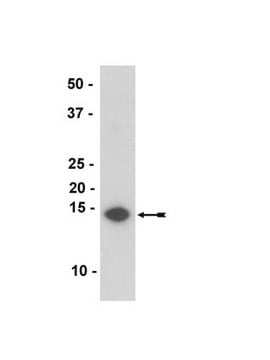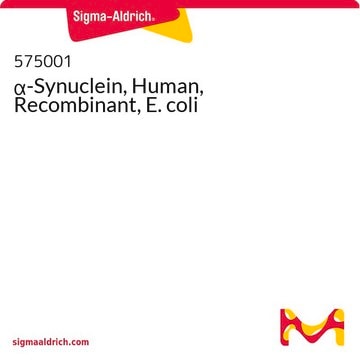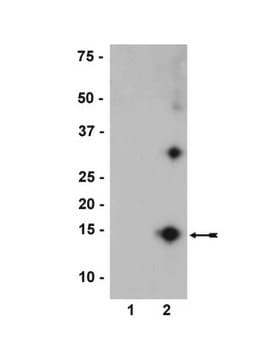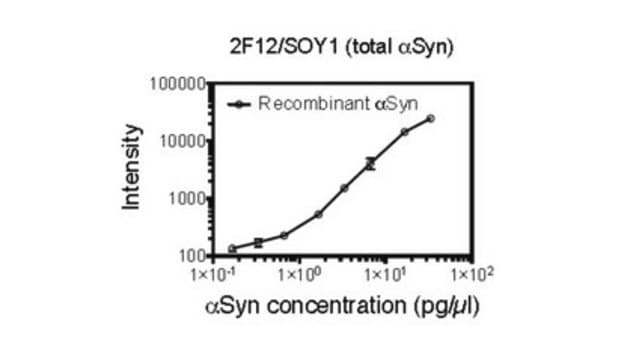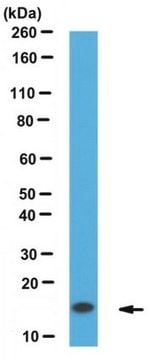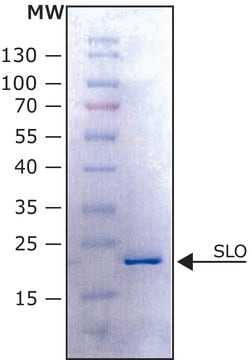推荐产品
生物源
mouse
品質等級
共軛
unconjugated
抗體表格
purified immunoglobulin
抗體產品種類
primary antibodies
無性繁殖
Syn211, monoclonal
形狀
buffered aqueous solution
分子量
antigen 19 kDa
物種活性
zebra finch, human
應無反應活性
rat, mouse
包裝
antibody small pack of 25 μL
濃度
~1 mg/mL
技術
immunohistochemistry: suitable
immunoprecipitation (IP): suitable
western blot: 0.25 μg/mL using recombinant human α·-synuclein.
同型
IgG1
UniProt登錄號
運輸包裝
dry ice
儲存溫度
−20°C
目標翻譯後修改
unmodified
基因資訊
human ... SNCA(6622)
一般說明
SNCA(突触核蛋白α)基因定位于人类染色体 4q22.1上。该基因编码一种名为α-突触核蛋白的小突触蛋白。
SNCA(突触核蛋白α)基因编码一个 140 个氨基酸的蛋白α-突触核蛋白,位于人类染色体4q21-23上。
免疫原
重组人 α-突触核蛋白。
生化/生理作用
少突胶质细胞中α-突触核蛋白累积会导致髓鞘质损失并引起神经变性,从而导致多系统萎缩。目前确知,α-突触核蛋白可诱导少突胶质细胞成熟。其编码的蛋白质是公认的重要路易体聚集体,参与帕金森病的发病机制。
目前确知,α-突触核蛋白可诱导少突胶质细胞成熟。少突胶质细胞中α-突触核蛋白累积会导致髓鞘质损失并引起神经变性,从而导致多系统萎缩。SNCA 基因突变会导致帕金森病。
外觀
溶于0.01M磷酸盐缓冲盐水,pH 7.4,含有1%牛血清白蛋白以及15 mM叠氮化钠。
其他說明
免責聲明
除非我们的产品目录或产品附带的其他公司文档另有说明,否则我们的产品仅供研究使用,不得用于任何其他目的,包括但不限于未经授权的商业用途、体外诊断用途、离体或体内治疗用途或任何类型的消费或应用于人类或动物。
未找到合适的产品?
试试我们的产品选型工具.
儲存類別代碼
10 - Combustible liquids
水污染物質分類(WGK)
WGK 3
閃點(°F)
Not applicable
閃點(°C)
Not applicable
其他客户在看
Regional deficiencies in chaperone-mediated autophagy underlie α-synuclein aggregation and neurodegeneration
Malkus KA, et al.
Neurobiology of Disease, 46(3), 732-744 (2012)
Kavita Prasad et al.
Brain pathology (Zurich, Switzerland), 22(6), 811-825 (2012-03-29)
The role of Lewy bodies, Lewy neurites and α-synuclein (αSYN) in the pathophysiology and diagnosis of Parkinson's disease (PD) is unclear. We used postmortem human tissue, a panel of antibodies (Abs) and confocal microscopy to examine the three-dimensional neurochemical anatomy
Sabrina Büttner et al.
The EMBO journal, 32(23), 3041-3054 (2013-10-17)
Malfunctioning of the protein α-synuclein is critically involved in the demise of dopaminergic neurons relevant to Parkinson's disease. Nonetheless, the precise mechanisms explaining this pathogenic neuronal cell death remain elusive. Endonuclease G (EndoG) is a mitochondrially localized nuclease that triggers
α-synuclein in blood and brain from familial Parkinson disease with SNCA locus triplication.
Miller DW, et al.
Neurology, 62(10), 1835-1838 (2004)
Interactions of Pathological Hallmark Proteins
Olah J, et al.
The Journal of Biological Chemistry, 286(39), 34088-34100 (2011)
我们的科学家团队拥有各种研究领域经验,包括生命科学、材料科学、化学合成、色谱、分析及许多其他领域.
联系技术服务部门